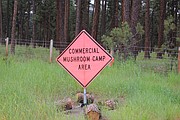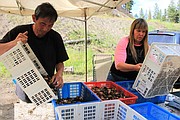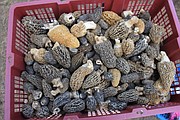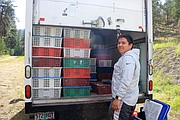Bumper crop: Morel mushroom picking season ending
Alongside Quartz Creek Road at the Tarkio exit, a small table covered by a white canopy was set up next to a refrigerated truck. A sign with purple and pink letters reads, “Mushroom Buyer Jessica.” Jessica Cruz, along with her sons Timo, 16, and Lucas, 11, and her Asian partner simply referred to as “Q,” sit in lawn chairs - waiting for pickers to show up with baskets full of morel mushrooms.
The pickers are combing through the burned areas of the Sunrise Mountain Fire, where a bumper crop has been harvested since early spring. As a result of last year’s wildfires, migrant pickers, mostly from Washington and Oregon, have descended on western Montana and have set up make shift towns at local campgrounds.
The eastbound side of the Quartz Creek Campground, located east of Tarkio, has been designated as a Commercial Mushroom Camp area, and general camping is not allowed. Superior District Ranger Carole Johnson said their office sold 396 commercial permits this season, totaling $15,345 in revenue in addition to 152 camp permits. They haven’t had commercial camping since 2000, which was the last time there was significant fire activity in the area.
Last year, approximately 700,000 acres of forest land burned in the Northern Region - offering prime morel mushroom harvesting, which started on May 7. In addition to the Sunrise Fire, harvesters found a bountiful crop on the Sheep Gap, Moose Peak, West Fork, Deep Creek and Rice Ridge.
Cruz said she buys between 500 to 1,500 pounds of mushrooms per day, and is currently paying $7 per pound. Two days ago, she was paying $9 per pound, but the price fluxuates - depending on supply and demand.
“If the buyers have a stockpile, then the price goes down,” she said.
The mushrooms are sold to wholesale buyers, retail outlets and restaurants. Cruz also sells them direct online.
At the end of May, the prices of conica, which is a subspecies of morels, was at $4 per pound. After the conica’s slowdown, then the “grays” emerge, and they are a little higher in price.
“The grays are bigger and heartier, and weigh more when dehydrated,” she said.
She pulls a basket of grays out of the refrigerated truck, in a variety of sizes and colors. Some of the sponge-like tops were blond, and some were a dark gray ranging from one inch to over four inches.
Around 5 p.m., an Asian couple shows up with their harvest for the day. Refusing to be interviewed by the Mineral Independent, they put two baskets of conica and gray mushrooms on the table. Q and Cruz sort through the baskets, picking out the rejects.
“These are old, they will spoil too fast,” said Q of the rejects. “They are still good for dehydrating, but will spoil before we can sell them.”
Cruz has been a buyer for 20 years and spends the fall near her home in Cottage Grove, Ore., following the chanterelle mushroom harvest, which typically runs from September until December. After school is out, her kids join her for the morel season. They spend the day dehydrating mushrooms, doing some picking themselves, and simply enjoy being outdoors. “It’s just beautiful here, and this morning we saw a moose walking down the road,” Cruz said.
There are several buyers in the area, include a few in Superior, one in Plains and Libby, and Seeley Lake. When temperatures warm up the morels dry out, and the tips will get sunburned. The commercial season ends on July 7, and the migrating troops will move onto other areas and even other crops. Some will switch to harvesting huckleberries, which ripen in the mountains around August.
The general public can pick up to five gallons of morels per day with a maximum of 20 gallons for the season. These permits are free of charge and good until the end of July. Morels that are grown in burn areas are considered sterile, and they only need to be rinsed off before consuming. Morels not found in burned areas need to be soaked in salt water in order to get the bugs out.
Cruz said they should not be eaten raw, and recommends people who have never tried them to take a small taste to make sure they do not have an allergic reaction. Her favorite recipe is to cut them in half, and fill them with a cream cheese and pesto mix topped with parmesan cheese. They are then baked at 450 degrees for five to seven minutes, and then broiled for a minute. “They are delicious,” she said.
Q prefers them in a cream sauce over chicken or steak and surprisingly, her sons don’t like mushrooms — despite working with them daily. Online, morels are sold anywhere from $20 a pound to several hundred dollars. Vendors can be found at local farmers markets selling fresh and dehydrated mushrooms, and local restaurants like the River Edge Resort near Alberton will often have them on the menu, especially when in season. They last about 10 days when fresh and several months when dried and frozen.
Despite the increased number of workers in the area, there weren’t any major incidents, said Johnson. The only incident that happened was at the end of May when a fight broke out in the camp. A man was stabbed with nonlife threatening wounds, and was taken to the hospital.
Other incidents have involved Immigration Customs Enforcement or ICE where 10 individuals were arrested in a raid of the mushroom camp at Quartz Creek on May 31. As a result of those raids, court records show there were charges against three men. Andres-Gregorio, a Guatemalan national, was charged with assault after punching a federal officer. Fernando Cruz Matias and Rogelio Jaimes Estrada were charged with illegal reentry of a deported alien.
The report also stated that about 15 other people at the camp fled when the federal agents arrived.











